Contributory members are able to log private notes and comments about each site
Sites Anne T has logged. View this log as a table or view the most recent logs from everyone
Kalmott cairn circle
Date Added: 9th Sep 2014
Site Type: Ring Cairn
Country: England (Cumbria)
Visited: Yes on 7th Sep 2014. My rating: Condition 3 Ambience 3 Access 4
Kalmott cairn circle submitted by VapourTrail on 28th Sep 2009. Kalmott cairn on a typically dull Cumbrian day in September.
(View photo, vote or add a comment)
Log Text: Kalmott Cairn Circle, Oddendales, Cumbria: Arriving at Oddendales to see the cairns marked on the OS map, just past the footpath sign pointing us to the Coast-to-Coast/Crosby Ravensworth, we were surprised to come across what appeared to be a small cairn with a ring of stones with a central cluster. It’s not marked on the Ordnance Survey maps.
Sitting between the stone wall of Oddendales Farm on the left and the modern trackway we were walking on, it seemed surprising that this cairn had survived intact. Not been able to find out any more about it, which has been frustrating. I record a photograph here to show what we saw. I’ve now only just found a photograph and brief description about this on Hedge Druid's web site; Hedge Druid says he then submitted it to the Portal for inclusion.
Having taken a couple of photos, we then made our way up to Seal Howe Cairn.
Raise Howe Cairn
Date Added: 9th Sep 2014
Site Type: Cairn
Country: England (Cumbria)
Visited: Yes on 7th Sep 2014. My rating: Condition 2 Ambience 3 Access 5
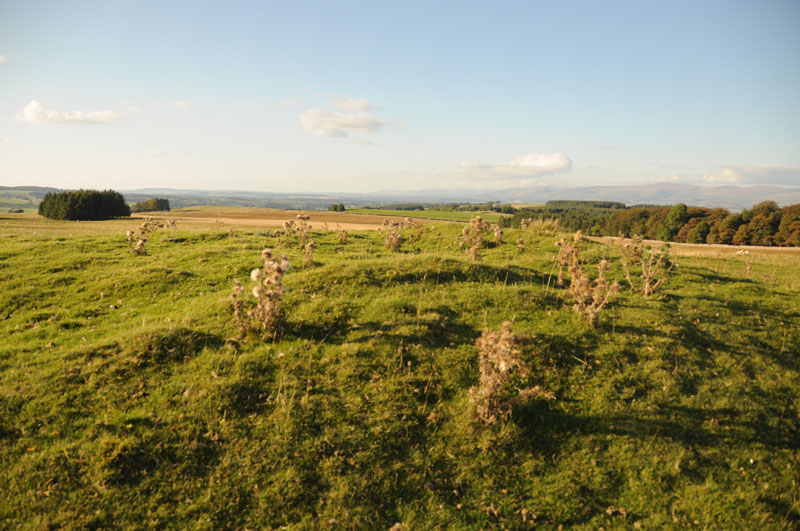
Raise Howe Cairn submitted by Anne T on 9th Sep 2014. Standing on top of Raise Howe Cairn looking north/north-east with Maskriggs Wood at the top right hand side of the picture.
(View photo, vote or add a comment)
Log Text: Raise Howe Cairn, Cumbria: From Gamelands Stone Circle, 1 km east of the village of Orton, we drove back into the village and found the B6260 which heads over the moors towards Crosby Ravensworth and Appleby-in-Westmorland. The road climbs steeply from Orton, leading up onto Orton Scar, Beacon Hill and Gaythorpe Plain. We stopped quickly to see if we could see Gamelands within the context of the landscape, but it seemed to be hidden within a dip beneath Knott Hill in the distance.
The B6260 is a very fast road and once on moorland we needed to be careful of the sheep meandering at the side (and sometimes across) the road. At first glance, you might be forgiven for thinking that Raise Howe Cairn is just a spoil heap next to a quarry, but parking on the verge opposite and walking up to the cairn, its shape and function become apparent. Limestone rubble appears under the soil and turf, and at the top of the mound, there are humps and bumps which make it appear as if the mound has been excavated (although the English Heritage Pastscape records say it has not been).
Our first reaction was “what a spot to be buried in” – there are 360 degree views all around and the landscape as a whole seems too large to take in. The Scale Beck valley lies to the east, the Lyvennet Beck valley to the west and the river Lune in the distance to the south.
Having checked the English Heritage records on my return home, they tell me this is a turf covered, slightly mutilated oval mound of earth and limestone rubble up to 1.2 high, maximum dimensions 23m x 18m and dates from the Bronze Age.
This seems to be a popular picnic spot as there was a lot of rubbish lying around, and a sign next to the quarry says ‘no motor vehicles’ as if someone might drive over the edge of the quarry face.
Not particularly a place to travel to just to see the cairn, but well worth stopping to appreciate the beauty of the landscape and the burial practices of our ancestors.
Thunder Stone (Castlehowe Scar)
Date Added: 9th Sep 2014
Site Type: Natural Stone / Erratic / Other Natural Feature
Country: England (Cumbria)
Visited: Yes on 7th Sep 2014. My rating: Condition 3 Ambience 3 Access 4
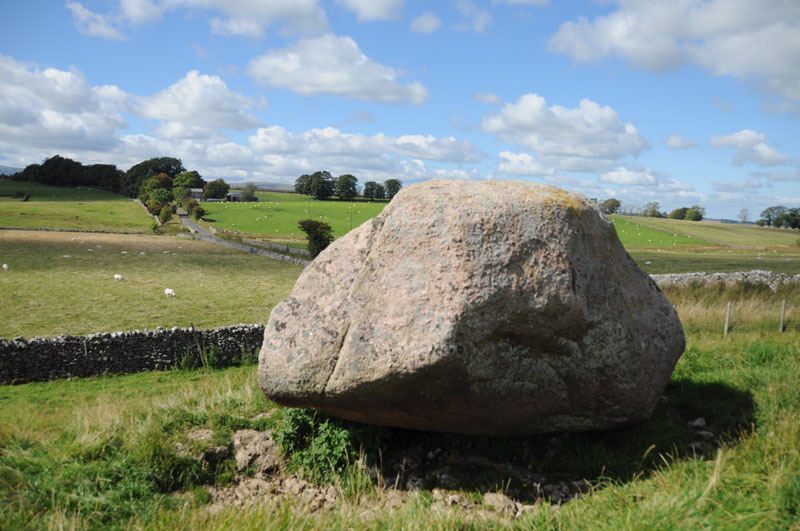
Thunder Stone (Castlehowe Scar) submitted by Anne T on 8th Sep 2014. Another face of this Thunder Stone. The red of the Shap Granite can be clearly seen in the strong sunlight.
(View photo, vote or add a comment)
Log Text: Thunder Stone (Castlehowe Scar), near Shap, Cumbria: When my husband suggested going back to Shap, I groaned inwardly - another day of walking round searching for stones within the village? But I was in for a great surprise. Andrew had identified stone circles and cairns within a few miles of each other, and we had a great afternoon.
On our way to Castlehowe Scar Stone Circle, I spotted two thunder stones marked on the map near Castlehowe Scar Farm on the way to the circle.
From Junction 39, Shap Interchange on the M6, turning right to drive through Shap Village, we took the right hand turn leading to Crosby Ravensworthjust after the Fire Station on the left, and immediately before the chip shop. This road looks as if it is leading into a housing estate, but it does go onto other villages.
Just after passing over the cemetery on the right hand then, then going over the two bridges over the M6 carriageways, I spotted the first of the Thunder Stones, and we stopped on the road for me to take a few photographs. There seem to be so many other erratics in this area, that by the end of the afternoon, I became a little immune to them! This one stood out at the right hand side of the road, perched on the edge of a small quarry. A footpath leading to Hardendale gives access onto the field and it’s possible to go and walk round three sides of the stone (four if you don’t mind heights). It looks as if it is made of Shap granite and in the strong sunlight the red of the Shap Granite stood out beautifully.
[But since the visit, I'm left wondering if this stone is an erratic, as the quarry seemed to be limestone, and the Thunder Stone red Shap granite. Was this stone deliberately brought up the valley to form part of a row to the stone circle? The complexity of the monuments around Shap is quite mind-blowing, especially after our day wandering around some of the gems around Shap.]
Having taken my photographs, we went onto the Castlehowe Scar Stone Circle which is less than one kilometre east of this stone.
Gamelands
Date Added: 8th Sep 2014
Site Type: Stone Circle
Country: England (Cumbria)
Visited: Yes on 7th Sep 2014. My rating: Condition 3 Ambience 4 Access 4
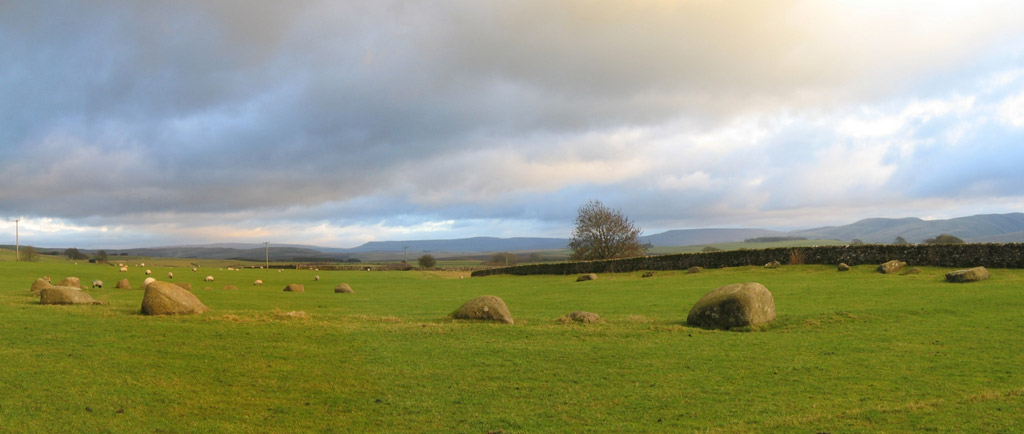
Gamelands submitted by LivingRocks on 8th Feb 2005. Photographed in November 2004 with short grass, a superb site even though the stones are all fallen.
(View photo, vote or add a comment)
Log Text: Gamelands Stone Circle, near Orton, Cumbria: By now, it was late afternoon, with the evening rapidly approaching, and almost time to head off home. From the Oddendale Cairns and Stone Circle we headed off in search of something to eat and drink before finding Gamelands. In Orton, we found the Chocolate Factory still open and busy, so stopped off for very welcome refreshments.
I found navigating to this stone circle tricky, as it’s on the edge of two map sheets, so we took the wrong road out of Orton before identifying the right minor road, signposted to Raisbeck. Following the B6261 past a minor crossroads just out of Orton village (the left hand side being Street Lane), the B road shortly afterwards turns to the right; the minor road needed to get to Gamelands Stone Circle carrying straight on to Knott Lane, signposted as ‘Public Byway leading over Knott Green to Public Bridleway’. Knott Lane is about 1 mile east of Orton. When we visited, there was a large pile of stones, being used to repair the bridleway blocking part of the entrance, but the minor road was wide enough (just) to bump up onto the grass verge and leave the car to walk up Knott Lane.
As we walked up the bridleway, we didn’t see the stone circle until we were almost upon it. The farmer has put in what looks like a relatively new wooden kissing gate to let people access the field, which was refreshingly nice. Thank you, Mr. Farmer! This is one of the largest stone circles we’ve seen in this area; the Visit Cumbria website tells me that this circle is some 100 yards in circumference.
All the stones have fallen, and it must have been impressive when they stood upright. This stone circle (oval) is certainly in a lovely location and very tranquil. It is situated on a plateau immediately below the impressive Knott Scar which rises up to the North, with spectacular views over the Eden Valley and the North Pennines.
I got to see at close hand how the Shap Red Granite is made up – with large ‘tabular’ feldspar crystals glinting out from the whole. My husband has seen this type of granite polished and used in construction projects/buildings, and if our ancestors did polish these stones, then this circle must have been fantastic when it was created.
After spending some time here, just soaking in the atmosphere, we left to go home, with one final stop, at Raise Howe Tumulus, which was on our way home. A glorious afternoon, very well spent.
Castlehowe Scar Stone Circle
Date Added: 8th Sep 2014
Site Type: Stone Circle
Country: England (Cumbria)
Visited: Yes on 7th Sep 2014. My rating: Condition 3 Ambience 4 Access 5
Castlehowe Scar Stone Circle submitted by baz on 3rd May 2003. Castlehowe Scar Stone Circle (NY587155).
Ten stones form this small stone circle which is now huddled up against a drystone wall, in a field with a locked gate. On the other side of the wall, there appears to be a stone row.
(View photo, vote or add a comment)
Log Text: Castlehowe Scar Stone Circle, near Shap, Cumbria: Having previously stopped at the Thunder Stone 200 metres to the west of Castlehowe Scar Farm, we drove almost 1 kilometre up to this little stone circle. All the land from the Thunder Stone up to Castlehouse Scar Wood on the right hand side of the road is labelled as access land on the Ordnance Survey maps. Immediately before the wood there is a single track metalled road, which turns right towards Hardendale Quarry, with room for 2-3 cars to park on the verge next to the field containing the stone circle.
Whilst the land is labelled access land, there was a padlock on the gate to the field, so we explored from the field next door, where there seemed to be a few red granite stones poking up through the grass in the field. ‘A stone row’, my husband pronounced.
Having driven over 60 miles to get here, and having checked that the field really was access land, in frustration we ended up climbing over the gate to walk quickly round this small stone circle (this is in complete contrast to the farmer at the Gamelands Stone Circle, near Orton, who had very kindly put in a kissing gate to allow entry). There was a water container left close to the stones by the farmer, and I was sorely tempted to try and move this out of the way to avoid it spoiling the photographs, but didn’t dare (and I suspect I would have needed a tractor to attempt it).
All the stones were red Shap granite – we wondered after if they had been polished at some stage in the past to make them shine. The red of the granite certainly stood out amongst the white/grey of the natural limestone bedrock nearby. Checking on the geology of the area when we got home, these red granite stones seem to only came from a very small area, so any of these red stones would have needed to have been quarried and moved up to their current locations.
Strangely, to me, the size of the stones seemed large in comparison to the diameter of the circle, as they did what remained of Kemp Howe at the edge of Shap Village.
Whilst we were parked at Castlehowe Stone Circle, there were many cars coming and going – dog walkers, people doing outdoor activities (we thought they might be cavers) and the owner of the wood next door. Curious that so many people were around, but no-one took any notice of the stone circle, apart from us – perhaps they are all too familiar with it.
We next drove on to Iron Hill, further down the minor road running alongside Castlehouse Scar Wood to Hardendale Quarry to continue our Stone Circle and Cairn adventure.
Fontburn B
Date Added: 7th Sep 2014
Site Type: Rock Art
Country: England (Northumberland)
Visited: Yes on 5th Sep 2014. My rating: Condition 3 Ambience 4 Access 3
Fontburn B submitted by SolarMegalith on 16th Jun 2013. Decorated horizontal surface of Fontburn B boulder (photo taken on June 2013).
(View photo, vote or add a comment)
Log Text: Fontburn B (Rock Art), near Rothbury, Northumberland: Fontburn Reservoir is just over 12 km north of Wallington and 9 km south-south-west of Rothbury. Despite it not being very far from where I live I can’t say I’ve ever heard of it this reservoir, yet it’s clearly very popular with fishermen and has a cafe that’s open at weekends. On the map, there were no clear roads up to the reservoir yet two car parks clearly marked, so this was a little bit of a voyage of discovery. And there it was - a single track road with passing places that wound its way up past Roughlees Farm and the Goats On The Roof cafe to the dam.
Parking at the southern-most end of the car park, as far as we could get past the fishing shack, we walked clockwise around the lake. From the car park, heading southwards, a barrier blocks entry to cars, but the footpath turns and continues westwards along a grassy track, wending through the trees with the reservoir to the right hand side. There are good, solid boardwalks in the boggiest areas and wooden guard rails at some of the edges of the lake (but not always in the steepest places); being someone who hates sheer drops, the height down to the lake wasn’t too bad, and it was an easy path to walk on. About a third of the way around the southern side of the reservoir, the path divides. The small track which follows the edge of the reservoir enters a nature reserve and disappears amongst the trees; the footpath signs turn you left, leading up a slight hill to a gate (with a very heavy spring) which took you onto Access Land (avoiding the nature reserve) where the terrain was much rougher and more difficult to walk with humps and bumps and small streams to cross.
We missed the first stone, Fontburn N02, at grid reference: NZ0395993186, as in the trees along the riverside walk it was difficult to gauge how far we had gone. By the time we came to the access land and orientated ourselves using the fence boundaries and the sheepfolds, we had to walk a fair way back to see NO2, and decided to go back to it on the return journey. But an hour later, the skies were heavy and grey and it felt like thunder, so we returned to the car along the easier footpath to the north of the reservoir.
As an aside, we came upon an unknown Rock (Grid reference: NZ0310993518) just to the left hand side of the path. Just into the access land, we came upon what looked like the remains of a cairn, but couldn’t be sure as field drains had been dug into the field around it, but there was a clear oval shape in the grass, topped by stones. Just after this, we found the said stone sitting alongside the left hand side of the footpath, although it wasn’t clear if there was rock art on it. There was also a smaller stone located alongside with other marks on it. Looking this up on the ERA database and the Portal, there are no references to this rock at all, so the marks are just weathering or perhaps where ploughs have hit it [note: we missed Fontburn N01, which is located between the two halves of the car parks at the eastern end of the reservoir! grid reference: NZ 04897 93466].
Continuing along the footpath, and rounding the right hand turn it takes, Fontburn B came clearly into view to the left of the footpath. It looks like an erratic dropped at the side of the path above the (now) reservoir. It’s impressive in size, although it looks as if the northern edge has been quarried away as there is a sheer, rather than a rounded face on this side.
A few cup marks were visible from the ground, and many more visible by climbing a few metres up the hill to the south. Even better was just to carefully hop up the side of the rock and sit on top of it, just like our ancestors must have done all those thousands of years ago. In the sunshine, it was a remarkable spot, although dominated by the ground rising to the south. In the past, there would have been clear views down to the river below.
We then carried on following the footpath to where it loops back round to the reservoir, and goes back onto the Northumberland Water Board Water Trail and onto Fontburn Four-Poster.
Doing some research on the web since getting home, I’ve discovered that Fontburn B is a published landmark/site to see on the National Trust Greenleighton Moor Walk around the Wallington area.
Fontburn Four-Poster
Date Added: 7th Sep 2014
Site Type: Stone Circle
Country: England (Northumberland)
Visited: Yes on 5th Sep 2014. My rating: Condition 3 Ambience 4 Access 3
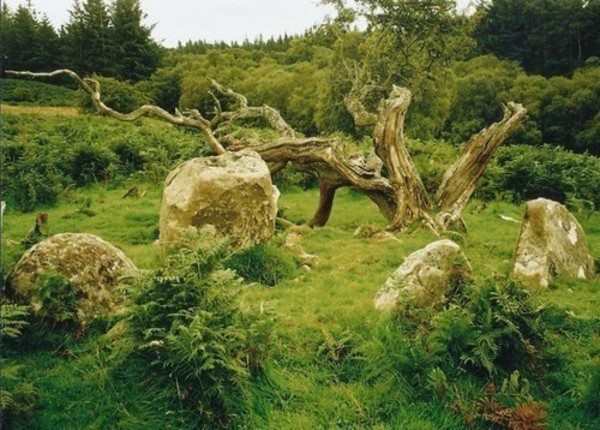
Fontburn Four-Poster submitted by Bladup on 30th Dec 2013. Fontburn Four-Poster.
(View photo, vote or add a comment)
Log Text: Fontburn Four Poster, near Rothbury, Northumberland: This was a continuation of our very pleasant meander around Fontburn Reservoir from Fontburn B.
Crossing over Fallowlees Burn and just starting to head back along the northern edge of the reservoir the Stone Circle comes into view on the horizon at the top of the hill.
My first impression is that this is a cairn, as there are many more stones around than the four uprights, but then why would two of the stones have cups on the top surfaces if they were meant to be covered up? Perhaps the site was used in antiquity? This site is likened to Goatstones Four Poster, but I’m not sure I saw much similarity (I'll need to sit and compare images).
Sitting on this small plateau with Dod Knowe hill rising up behind, and with the burn trickling pleasantly down below, this small stone circle is in a peaceful and lovely spot. It’s also very atmospheric, with the very old (hawthorn?) tree lying in broken pieces at the feet of the circle. There appear to be clear cup marks on two of the stones.
It was a very misty day, so we couldn’t make out any of the distant landmarks, so after lingering for a while to absorb the atmosphere, we made our way back to the marked path and walked back round to Fontburn Dam.
The place to seek permission to visit Fontburn Stone Circle is Newbiggin Farm, north of the reservoir, although there are references to finding the stone circle on the notice boards by the reservoir.
North Plantation A
Date Added: 6th Sep 2014
Site Type: Rock Art
Country: England (Northumberland)
Visited: Would like to visit
North Plantation A submitted by SolarMegalith on 5th Oct 2013. Simple cup-marks near the top of the panel (photo taken on October 2013).
(View photo, vote or add a comment)
Robin Hood's Well (Chollerton)
Date Added: 4th Sep 2014
Site Type: Holy Well or Sacred Spring
Country: England (Northumberland)
Visited: Yes on 3rd Sep 2014. My rating: Condition 1 Ambience 2 Access 4

Robin Hood's Well (Chollerton) submitted by Anne T on 4th Sep 2014. Walking across the field from the footpath from the B6342 to Well House Farm, this is the first view of Robin Hood's Spring/Holy Well. [I double checked the grid reference to ensure I had the right place].
(View photo, vote or add a comment)
Log Text: Robin Hood's Well, Colwell, Northumberland: I last visited Colwell on 13th June 2014, when we went in search of the old chapel (located in someone’s back garden, so not accessible without permission), the two wells in the centre of the village – Coley’s Well and Pricky’s Well – and Blue Crags Hill Fort (also known as Brecken Hills Fort).
Both Coley’s Well and Pricky’s Well are at the eastern edge of the village at the cross-roads where the northern most side-road from the A68 leads eastwards to meet the B6342. Whilst part of the area’s rich history, neither well is pleasing to the eye (very similar to Meg’s Well in Aydon). They sit alongside a small stream, the Coal Burn.
About 200 yards south of the village is a third well, Robin Hood’s Well. As this is recorded as a holy spring, I was keen to see this, so stopped off whilst I was passing by.
There is parking in a layby by the road junction mentioned above, near to Pricky’s Well. From here, it is a 200 yard walk south down the B6342 to the footpath which leads eastwards towards Well House (grid reference: NY 96641 74198. This is a very busy little road, with no footpaths, so I had to keep stepping up onto the grass verges to avoid the traffic.
Robin Hood’s Well is almost on the field boundary next to the road. To reach it, on opening the gate to the field by the footpath sign, you need to turn right immediately and walk 50 yards or so to the south (towards the woodland). The first view is of a post sticking up from marsh grass, which looks like a fence post. As you get closer, you will see a stone lying next to the post. A closer look shows a pool of water around the post and stone, and boggy ground surrounding it – a shame it is so unremarkable for such a historic well.
There is a further spring which appears 100 yards further south down the field, which has a clearer water course marked by stones on either side, but was dry (although the ground was very boggy) on the day of my visit.
At (or near) Well House Farm (according to the Hexham Courant and Visitor UK web sites) there is also a fourth sulphurous well, The Bore Well, reputed to improve fertility and which is well cared for with a proper housing.
Chesters Roman Site b
Date Added: 3rd Sep 2014
Site Type: Rock Art
Country: England (Northumberland)
Visited: Yes on 25th Aug 2014. My rating: Condition 4 Ambience 4 Access 4
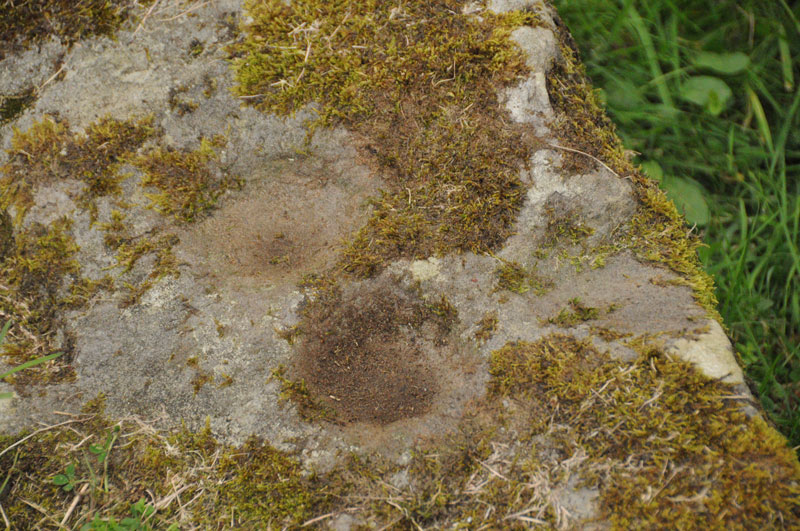
Chesters Roman Site b submitted by Anne T on 1st Sep 2014. Photograph showing two cup marks (0.09m) on stone, with third just on right hand edge.
(View photo, vote or add a comment)
Log Text: Chesters Roman Bridge Rock Art, Chollerford, Northumberland: Parking at the George Hotel at Chollerford on the north side of the river Tyne, we walked back over the bridge and found the small gate to the west side of the bridge to the footpath leading to the Roman Bridge. This is a really easy walk along a long straight footpath defined by wired fences on both sides (it feels like being a sheep being herded to a pen!). After a short kilometre, the path bears right down to the river, and a further gate lead to remains of two old Roman bridges on the same site. The ruins are impressive.
There seems to be some confusion about what rock art is at this site, and what isn’t. What is certain is that we found a stone block with three clear cup marks on in the location described by the England’s Rock Art record 769. Thank goodness we had the images of the location of this stone downloaded onto my phone, otherwise we would have spent hours searching the bridge piers.
This is a lovely location, right next to the Tyne, surrounded by old Roman remains. It would have been nice to have been able to see the other two stones purportedly found here, too.
There are also substantial remains of the bridges and other structures on the northern bank of the Tyne, which we'll go back and explore at some time in the future.
Our find was 'rewarded' with a drink at the hotel afterwards - this was a very pleasant early evening in late August.
Wall Crags Settlement
Date Added: 3rd Sep 2014
Site Type: Ancient Village or Settlement
Country: England (Northumberland)
Visited: Yes on 25th Aug 2014. My rating: Condition 2 Ambience 3 Access 4
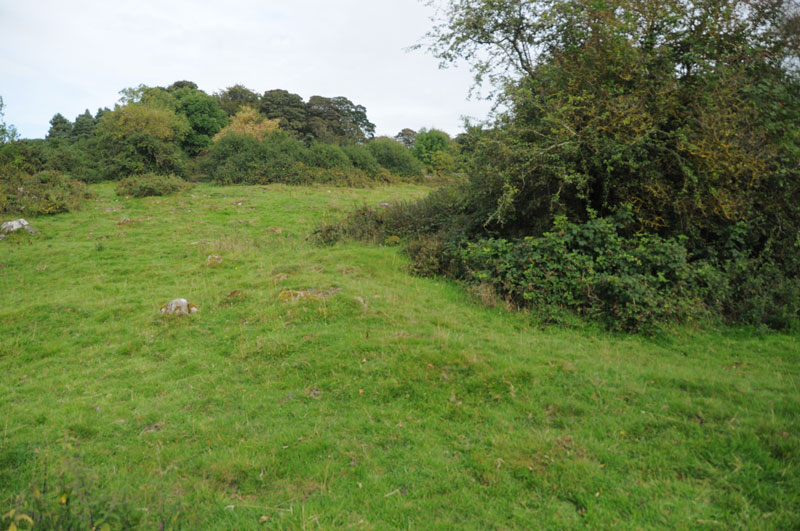
Wall Crags Settlement submitted by Anne T on 1st Sep 2014. To our untutored eye, the circular bank running from the centre of the photograph to the right hand side looked like the possible foundations of a roundhouse (now has trees growing in the middle).
(View photo, vote or add a comment)
Log Text: Wall Crags Settlement, Northumberland: It was 4pm on Bank Holiday Monday and we wanted to go somewhere, but didn’t have time to go far. Husband Andrew had spent the afternoonon the internet looking at rock art on the old Roman Bridges at Chollerford, and spotted the settlement to the east of Wall village as somewhere else to go on route. We drive through Wall on a regular basis, and neither of us had been aware of a settlement here until we looked closer at the map.
We parked on a side street just above the chapel in Wall at approx. grid reference NY 91744 69094, and walked down to the chapel, turning left towards the park. There were some very old cottages to our left hand side (on the walk back, I’m sure the one nearest the start of the footpath was dated 1642). The footpath took us across the southern end of the park, with a gate leading to some stone steps leading up the hill.
We climbed quickly up the steep slope, then the steps stopped, and open grassland began. The slope must have been about 40 degrees, and was slippery enough in the dry, and would have been lethal in the wet. I’m afraid I bottled out at this point - getting up would have been OK, but getting down (for me) would have been a nightmare, so I sat on the grass and handed the camera to Andrew, so he's to thank for the images on the Portal.
He was gone about 20 minutes, coming back to say it was fairly difficult to identify the features up on top of the hill, as whilst the top was level, there were trees, large stones and the ground looked as if it had been heavily trampled by cattle and was difficult to walk on. The ramparts were visible, as were the possible foundations of a couple of roundhouses.
I haven’t been able to find out much about this settlement at all, except for a brief mention on Keys To The Past (page reference N13760) which is a shame, but I’ll keep my eyes open for any information.
Doddington Moor
Date Added: 1st Sep 2014
Site Type: Stone Circle
Country: England (Northumberland)
Visited: Couldn't find on 30th Aug 2014
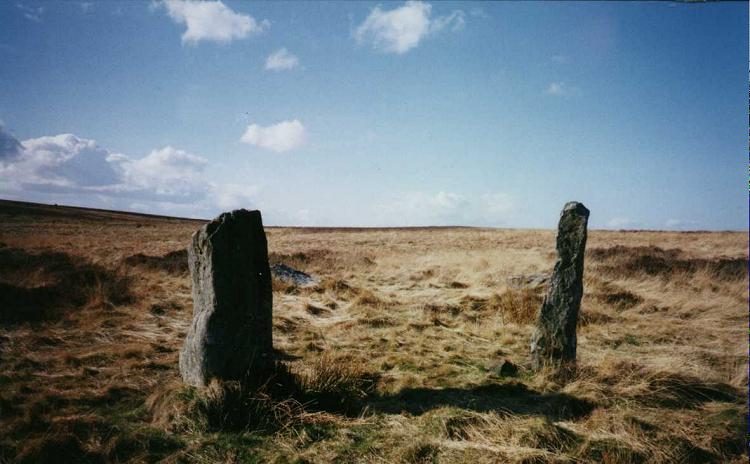
Doddington Moor submitted by Andy B on 24th Nov 2001. Doddington Moor Stone Circle
(View photo, vote or add a comment)
Log Text: Doddington Stone Circle, Northumberland (second failed attempt!). Having visited Weetwood Moor, as we were so near, and it was still only relatively early (5pm), we decided to drive a couple of miles further up the road to Weetwood Hall and try the footpath I’d identified as a possible easier route to Doddington Stone Circle.
We parked the car park where the footpath splits off northwards from the road just after Weetwood Hall (there is just room for one car opposite the field entrance at the corner of the junction). There is a metalled road which goes past the two or more houses to the left hand side, then it become a grassy path between two hedges, with tractor ruts in either side. After about half a mile, just past a wood to the right hand side, there is a gate with a footpath sign on, and the track becomes quad bike marks in the grass, and we followed these up the hill. There is a new stile (narrow, but new) , then the track more or less disappears, and is marked by a series of Scots Pines, standing alone, but growing more or less in a line north-north-west up the hill.
Passing an outcrop of rock to our left hand side, we climbed to the brow of the hill, but just where the land started to go downhill again, we were met by boggy land, covered completely with a heavy coverage of low growing thistles and gorse, which went on as far as the eye could see. Andrew decided this was impossible, so we turned back and went to find the cup and ring marked rocks marked on the map on the way back down the hill.
We'd previously tried to visit on 17th August 2014, but the quarry next to Wooler Golf Club had been extended and the footpaths had disappeared (or we couldn't find them).
There is a third possible footpath to try, from West Horton, so this will go on the 'want to do' list.
Weetwood Moor 3a
Date Added: 1st Sep 2014
Site Type: Rock Art
Country: England (Northumberland)
Visited: Yes on 31st Aug 2014. My rating: Condition 3 Ambience 5 Access 4
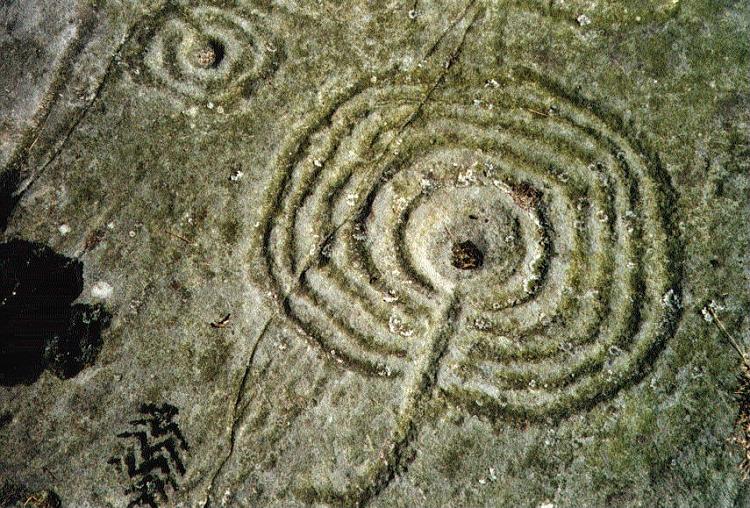
Weetwood Moor 3a submitted by rockartuk on 3rd Aug 2001.
(View photo, vote or add a comment)
Log Text: Weetwood Moor 3a (Bicycle Rock), Northumberland: My husband had seen photographs of the rock art at Weetwood Moor, which was very near the Fowberry Mains/Fowberry Park site we'd seen on 17th August 2014). Parking at the road junction next to where the metalled track runs alongside North Plantation, we walked down to find the footpath, which is located to the right hand side of the road, just passed the cattle grid. My goodness, was this overgrown for the first 20 to 30 metres – I stepped through head high bushes and gorse, eventually emerging into a rocky moorland.
After a 100 yards or so, the footpath bears left. There is a clear sign straight ahead, declaring ‘not access land’, but there was clear evidence of small footpaths carrying along across the heather. We went up a little way to try and see what was there, when a lady walking her dog sailed past us, waving and shouting ‘hello’ cheerfully as she went, so we assumed it was alright to carry on (we’ve since found a published Rock Art walk which takes us past the rocks we wanted to see).
Andrew found the Bicycle rock first of all – this was amazing - and I took photographs. To the east of this rock, someone had built a small cairn in a cup shape, this cup containing what looked like a Wiccan altar with sea shells, a bone and some berries.
Walking to the quarry face immediately to the east of Bicycle Rock, I noticed (for the first time) evidence of fluting on the edge of the rock, similar to the weathering on other standing stones in the area (ones that immediately spring to mind are Matfen and the Newtown Mill standing stone).
We found other rocks with cup marks, and I’ll need to sit down and compare my images to the other pages for Weetwood Moor on the Portal, to make sure I’m recording them against the right pages.
Tremaenhir Standing Stones
Date Added: 29th Aug 2014
Site Type: Standing Stones
Country: Wales (Pembrokeshire)
Visited: Yes on 22nd Aug 2014. My rating: Condition 3 Ambience 3 Access 5
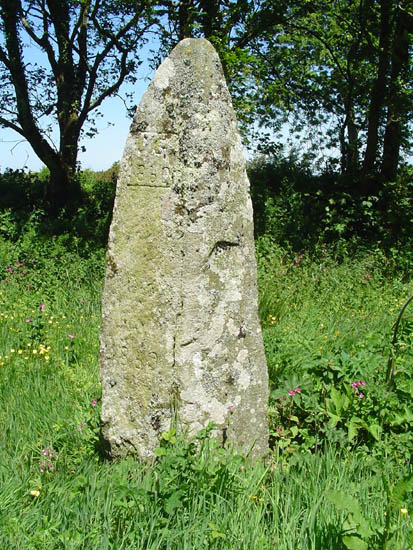
Tremaenhir Standing Stones submitted by PaulM on 6th Jun 2004. The village name suggests there are three standing stones in this village. This is the second of two marked on the OS map.
It is handily located on the grass verge so you can walk right up to it or view it from the comfort of your car seat.
This stone is located at SM827263 and has the initials "J.G." carved into it with the date 1860.
(View photo, vote or add a comment)
Log Text: Standing Stone by Tremaenhir, Pembrokeshire: After an amazing day at St. David’s Cathedral and Bishop's Palace, followed by St. Non’s Well, Chapel and standing stones, we were reluctant to call an end to the day, so we decided to drive along the A487, heading north to Tremaenhir Farm, where the map told us there were ‘Standing Stones’.
Just opposite the farm, there was a solitary tall standing stone, with only its top half poking above the undergrowth. We looked around for more, and couldn’t find any - although I did spot a tall shape in the bank opposite, which looked like it could have been a standing stone heavily covered by ivy.
It would be fun to go back in winter, when all the grass and weeds have died down, armed with the information and grid locations recorded here on the Portal.
St Non's Chapel
Date Added: 29th Aug 2014
Site Type: Early Christian Sculptured Stone
Country: Wales (Pembrokeshire)
Visited: Yes on 22nd Aug 2014. My rating: Condition 3 Ambience 4 Access 4
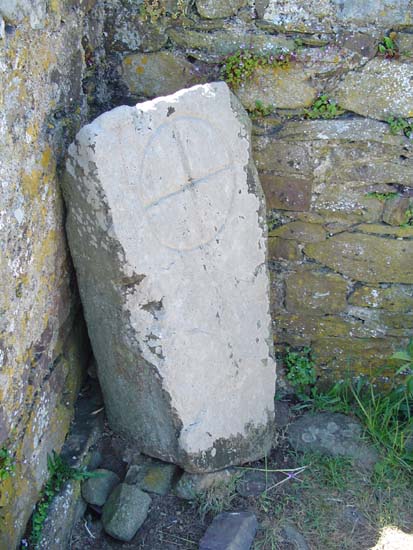
St Non's Chapel submitted by vicky on 7th Jun 2004. Within the ruined chapel of St Non's, around which are the remains of a possible stone circle, lies this inscribed stone. It is believed to date from the 7th-9th century AD and is decorated with a ring cross.
(View photo, vote or add a comment)
Log Text: St Non's Chapel, Pembrokeshire: A gate leading from between St Non’s Well (to our left) and the vault with her statue in (to our right), led into the field containing the chapel. It was a short walk to the ruined building, which is enclosed by a fence to protect it from the cattle in the field.
This chapel is very small, with an entrance to the west side. It is on a very steep site, and the walls to its southern side are composed of some impressively large stones.
Inside the chapel is a small white-painted cross, in the left hand corner as you face the sea. At its base are many offerings – tokens, tea-lights, a small memorial plaque and pebbles painted with people’s names.
Whilst we explored the stones in the field around the chapel, a Welsh family came and spent quite some time by the cross, and I wondered if they were laying their own offerings. This is certainly a superb spot to mediate and pray on a sunny day.
As we entered the field, it was apparent that there were some standing stones within the field, although I’d not seen these referred to until I logged onto the Portal when we got home. I’ve submitted some images of these along with the chapel.
St Non's Well (Pembrokeshire)
Date Added: 29th Aug 2014
Site Type: Holy Well or Sacred Spring
Country: Wales (Pembrokeshire)
Visited: Yes on 22nd Aug 2014. My rating: Condition 4 Ambience 4 Access 4
St Non's Well (Pembrokeshire) submitted by chestertourist on 27th Dec 2004. St Nons Well near St. David's.
(View photo, vote or add a comment)
Log Text: St Non's Well, Pembrokeshire: It was interesting trying to find the small road leading down to St. Non’s Chapel and Well; it turned out to be a side road off a side road, with a very, very narrow section coming out of St. David’s.
This road led down to St. Non’s Retreat Centre, with views over the sea. Just before the road reached the Retreat Centre, there was a small car park on the right hand side, with plenty of room for visitors, with only a short walk down to the well and chapel.
Approaching the well, my first view was a stone vault to the right hand side, with a white statue of a woman with her arms outstretched, and at first I thought this was St. Non’s Well. The actual well is a few steps further on to the left hand side. As we stepped down to see the source of the water, there was a continuous noise, like the well was connected to a blow hole at the bottom of the cliffs with the noise of the waves lapping at the entrance coming back up where we stood. We stood in silence, listening. “The well’s breathing!” I exclaimed. After a few more minutes, I realised that the noise came from the bullocks drinking from the small stream of water that emerged from the well into the adjacent field. Not a holy miracle after all, but it got the heart racing none-the-less.
We went onto explore St. Non’s Chapel and the standing stones in the same field, hopping onto the Coast Path (well my husband did – I couldn’t get over the stone stile in the south-western corner of the field, because of the proximity of the path to the drops down to the sea below). We watched a school of kayakers in the bay below, with blue sky and spectacular geology. I would have loved to have taken a flask of tea and just sat for a while taking this all in.
Whilst we were exploring the standing stones around the chapel, I noticed a family collecting water from the well.
Nevern Churchyard
Date Added: 29th Aug 2014
Site Type: Standing Stone (Menhir)
Country: Wales (Pembrokeshire)
Visited: Yes on 23rd Aug 2014. My rating: Condition 3 Ambience 4 Access 5

Nevern Churchyard submitted by PaulM on 19th Aug 2002. This standing stone inscribed with ogham can be found in Nevern churchyard close to the famous cross. Two other interesting stones, also descorated with ogham have been used as window sills inside the church.
(View photo, vote or add a comment)
Log Text: Nevern Churchyard, Pembrokeshire: After having felt ‘thwarted’ by the farmer’s notice to seek permission before accessing the Trafael Rock Art capstone (but with no details of who to contact) we cut our losses and drove back towards Newport to have a cup of tea and a piece of cake. We came across the pretty little village of Nevern. There was a crowd of people gathered around the bench and a large mounting block opposite the village hall river, so stopped to look. What a treat. A stream ran by the western end of the church, with a narrow well laid footpath above the stream, against the bottom of the church yard wall, so you could walk up to the little weir further upstream. According to the church guide book, the mounting block is only one of two left in Pembrokeshire.
The notice board by the bench told us that there was the remains of a castle, a church with two notable crosses, an old Pilgrim’s cross and other things to see. For today, we focused on the church where we found two ancient stone crosses, plus a stone with both Ogham and Latin inscriptions and an incised stone on the external wall of the church.
The church was atmospheric to start with, with its dark yew avenue. A lady was sitting on a tombstone under a yew tree immediately to the left of the gate, sketching, whilst her friend was recording and deciphering writing on tombstones nearby.
At first I couldn’t see the Great Cross, which was right next to the church wall, and partly hidden by the branches of the yew trees next to it. All four sides are heavily decorated with ribbons and interlacing symbols. The guide says the cross is 13 feet high, with the cross being 24.5 inches in diameter. Looking up to the top of the cross, the top seemed ‘too large’ for the shaft, as it protruded by at least an inch on each of the longer sides, and I wondered if these had been a ‘marriage’ but the styles of decoration matched perfectly.
Immediately to the east of the porch before entering the church is the Vitalianus Stone, which the guide book tells us may date from the 5th century, and also has Ogham and Latin inscriptions. On the church wall above the Vitalianus stone, there is an interesting weathered corbel of a male face.
On the north exterior wall of the church, at the left hand corner of the second window in the chancel, there is a lettered stone with a Latin inscription, which has apparently been recut.
Inside the church, as you look towards the east end from the nave, the nave seems to bend towards the south. The guide book says this is only a 1 degree angle, but actually seems a lot more.
There are a couple of very interesting and amusing memorials to members of the Warren family – one next to the Maglocunus Stone and the other in the west corner of the quire. The Maglocunus Stone is built into a window sill on the south side of the nave, and contains another example of Ogham and Latin inscriptions next to each other.
There was also a ‘weeping yew’ (second tree to the right as you entered the churchyard). The ‘bleeding’ limb was round the back of the tree (to the east), and really did weep a reddish liquid.
A couple of hours well spent, satisfying my interest for both church architecture and ancient monuments.
Garn Turne
Date Added: 28th Aug 2014
Site Type: Chambered Tomb
Country: Wales (Pembrokeshire)
Visited: Saw from a distance on 23rd Aug 2014. My rating: Access 1
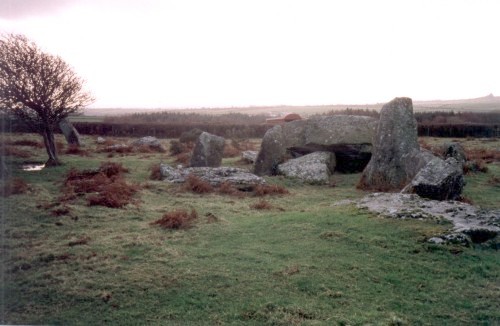
Garn Turne submitted by steveco on 24th Feb 2002. Garn Turn Burial Chamber SM979272.
(View photo, vote or add a comment)
Log Text: Burial chamber at Garn Turne Rocks, Pembrokeshire: (couldn't find anywhere to access this site): The final sites we wanted to see before hitting the motorway home to Northumberland were the burial chambers at Garn Turne. Having successfully located the field and the footpath nearest to the largest burial chamber, we parked in an extended passing place near the footpath. We met a couple of local ladies with their families picking blackberries in the hedgerows and chatted briefly, telling them where we were going; they didn’t seem to think there would be a problem with access.
Walking to 50 metres or so up the footpath to a gate in the field, we could see no access into the Garn Turne Enclosure. My husband hopped across the gate whilst I took photographs of the very curious cows in the adjacent field who’d come to see what we were up to!
From this footpath, the chamber appeared to be inaccessible – there seemed to be no gates whatsoever. When we looked at the Portal later in the day, there were lots of other photographs of this site, and we are left wondering how they accessed it. Other web sites mention squeezing through hedges, and I don’t like to do this without permission from the farmer. I had to be content with a photograph from a distance.
By way of compensation, we went to see Ogham and Latin inscribed stone at St. Dogwell’s Church (just marked as ‘Stone’ on the map, next to Sealyham Bridge).
However, there was a second chamber on the map, at approximate grid reference SM 98269 26566 (the UK Grid Finder’s images are shrouded in cloud, so can’t get a precise fix). We found the very overgrown footpath that took us closest to the chamber, only to be met by a very aggressive combine harvester driver, who forced us to reverse at least a quarter of a mile, pull over for him, then block our way. At this point we gave up and decided to head for home, only to catch up with said combine harvester and had to follow him at about 15 miles an hour for the next four or five miles (he refused to let us by at any available passing place).
Gors Fawr Outliers
Date Added: 28th Aug 2014
Site Type: Standing Stones
Country: Wales (Pembrokeshire)
Visited: Yes on 23rd Aug 2014. My rating: Condition 3 Ambience 5 Access 4
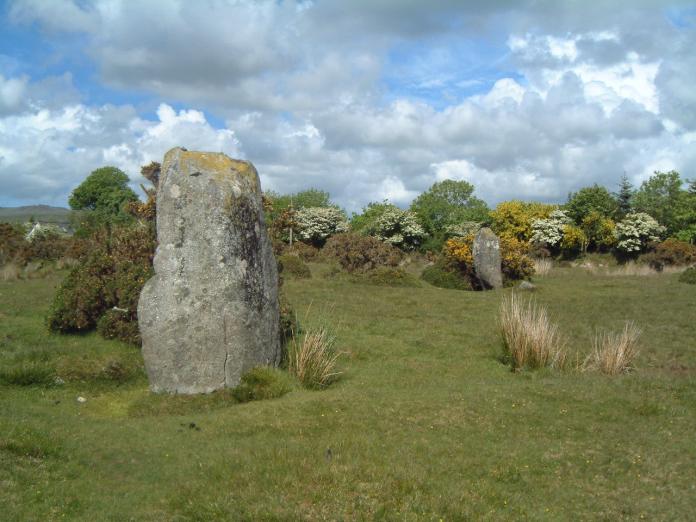
Gors Fawr Outliers submitted by enkidu41 on 3rd Jun 2004. These 6' and 5'7" stones lie 45' apart north-east of the circle. This shot proves that it's not always wet in Wales.
(View photo, vote or add a comment)
Log Text: Gors Fawr Outliers, Pembrokeshire: It was an easy walk of about 150 metres or so north-northeast across the moorland to the Gors Fawr Standing Stones/Outliers, which were visible from the stone circle.
Standing at the Outliers looking towards the circle, they do appear to be an entrance. We spotted other shaped stones lying in the grass, which looked like they may have formed part of a stone avenue at some point in the distant past.
One of the Outlier stones was shaped, as if it could be used to sit on. I understand from reading the Ancient Wisdom of Wales web site that this is called ‘the dreaming stone’ and has magnetic qualities.
With the Presili mountains in the background, I certainly had the sense of an ancient landscape with huge meaning for our ancestors, and wished I could tap into their thinking today.
I am interested in finding out about possible alignments between these Outliers, the circle and the Solstice – once I’ve processed all the photographs and notes I’ve taken from this trip!
Gors Fawr Stone Circle
Date Added: 28th Aug 2014
Site Type: Stone Circle
Country: Wales (Pembrokeshire)
Visited: Yes on 23rd Aug 2014. My rating: Condition 4 Ambience 5 Access 4
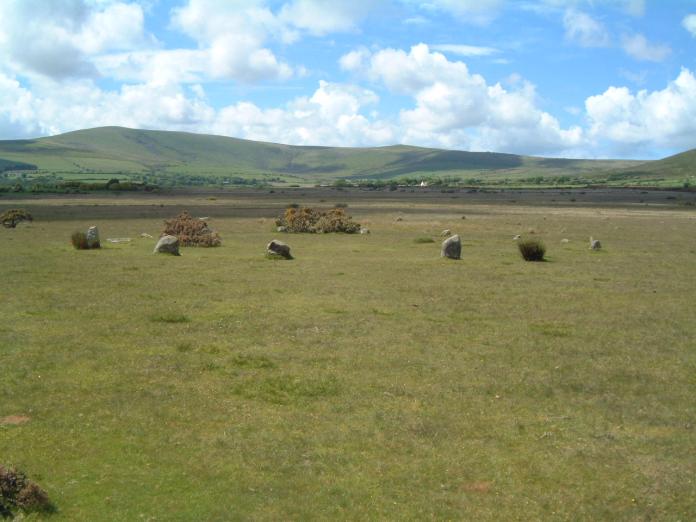
Gors Fawr Stone Circle submitted by enkidu41 on 3rd Jun 2004. A circle of 16 stones in an almost perfect 73’ diameter circle. This shot proves that it's not always wet in Wales.
(View photo, vote or add a comment)
Log Text: Gors Fawr Stone Circle, Pembrokeshire: After stopping off at St. Brynach’s church in Nevern to see the stone crosses, we started on our long journey home to Northumberland. We’d identified a number of ancient sites we wanted to see on our way back, including the Gors Fawr Stone Circle. My husband had hoped to see the site in the Presili Hills where they’d quarried the stones for Stonehenge, but time (and my horror of precipices and steep drops) wouldn’t allow – on our next trip, we’ll need to allow another month at least to see all the things we want to in the area!
Following the A478 and turning off towards Mynacholog-ddu at the village of Crymych, it was easy to find the little gem of Gors Fawr. Again, I hadn’t realised what a tourist attraction this was. There was a small lay-by across from the house ‘Pen-rhos’, and an easy walk across the field to the circle.
It was much smaller than I imagined from the photographs I’d seen on the Portal, but if I’m allowed to, I'd use the word ‘cute’ as the most accurate description that comes to mind. One of the first things I saw almost in the middle of the circle was a small Wiccan altar, made of small rounded blue pebbles, with its apex pointing towards the Gors Fawr Outliers.
Walking just outside the perimeter of the circle, we became aware of smaller stones buried in the grass at regular intervals about 3-4 metres outside the main circle, and wondered if there was an outer circle (but then there were so many other stones in the field that we let our imaginations run a little riot with ideas of stone avenues and tumuli). Since I've been home, I've read on the Ancient Wisdom of Wales web site that a survey had been done, and nothing found.
But what a place to build a circle – on a wide, flat plateau of moorland, with the Presili hills rising to the north. This stone circle seeming to lie in the centre of the graceful bowl formed by the hills, which rose up blue and misty in the distance. The circle somehow seemed to me to capture the essence and magnificence of the landscape.
There was a small, constant stream of other visitors. I got into conversation with a family who said they’d had trouble finding the circle, and had stopped by the Outliers and walked back. The man told us about the apparent alignments between the Outliers and the Circle at Solstice, so I’ll need to check this out. I didn't have the courage to ask him if he was another Portal user (but next time I won't be so shy!).
I would have loved to have stayed until sunset.
